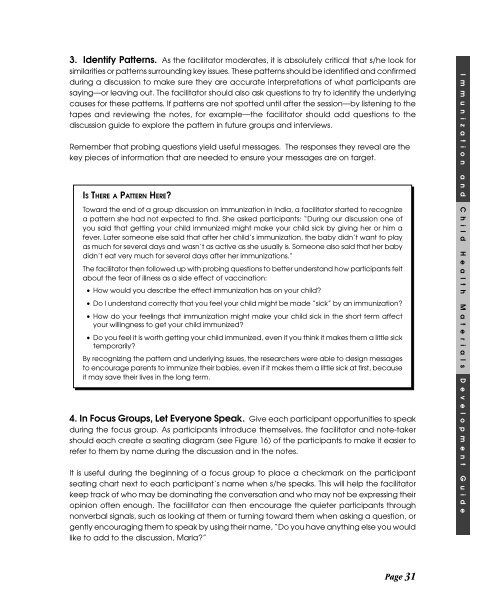Immunization and child health materials development guide pdf
Immunization and child health materials development guide pdf
Immunization and child health materials development guide pdf
Create successful ePaper yourself
Turn your PDF publications into a flip-book with our unique Google optimized e-Paper software.
3. Identify Patterns. As the facilitator moderates, it is absolutely critical that s/he look for<br />
similarities or patterns surrounding key issues. These patterns should be identified <strong>and</strong> confirmed<br />
during a discussion to make sure they are accurate interpretations of what participants are<br />
saying—or leaving out. The facilitator should also ask questions to try to identify the underlying<br />
causes for these patterns. If patterns are not spotted until after the session—by listening to the<br />
tapes <strong>and</strong> reviewing the notes, for example—the facilitator should add questions to the<br />
discussion <strong>guide</strong> to explore the pattern in future groups <strong>and</strong> interviews.<br />
Remember that probing questions yield useful messages. The responses they reveal are the<br />
key pieces of information that are needed to ensure your messages are on target.<br />
IS THERE A PATTERN HERE?<br />
Toward the end of a group discussion on immunization in India, a facilitator started to recognize<br />
a pattern she had not expected to find. She asked participants: “During our discussion one of<br />
you said that getting your <strong>child</strong> immunized might make your <strong>child</strong> sick by giving her or him a<br />
fever. Later someone else said that after her <strong>child</strong>’s immunization, the baby didn’t want to play<br />
as much for several days <strong>and</strong> wasn’t as active as she usually is. Someone also said that her baby<br />
didn’t eat very much for several days after her immunizations.”<br />
The facilitator then followed up with probing questions to better underst<strong>and</strong> how participants felt<br />
about the fear of illness as a side effect of vaccination:<br />
• How would you describe the effect immunization has on your <strong>child</strong>?<br />
• Do I underst<strong>and</strong> correctly that you feel your <strong>child</strong> might be made “sick” by an immunization?<br />
• How do your feelings that immunization might make your <strong>child</strong> sick in the short term affect<br />
your willingness to get your <strong>child</strong> immunized?<br />
• Do you feel it is worth getting your <strong>child</strong> immunized, even if you think it makes them a little sick<br />
temporarily?<br />
By recognizing the pattern <strong>and</strong> underlying issues, the researchers were able to design messages<br />
to encourage parents to immunize their babies, even if it makes them a little sick at first, because<br />
it may save their lives in the long term.<br />
4. In Focus Groups, Let Everyone Speak. Give each participant opportunities to speak<br />
during the focus group. As participants introduce themselves, the facilitator <strong>and</strong> note-taker<br />
should each create a seating diagram (see Figure 16) of the participants to make it easier to<br />
refer to them by name during the discussion <strong>and</strong> in the notes.<br />
It is useful during the beginning of a focus group to place a checkmark on the participant<br />
seating chart next to each participant’s name when s/he speaks. This will help the facilitator<br />
keep track of who may be dominating the conversation <strong>and</strong> who may not be expressing their<br />
opinion often enough. The facilitator can then encourage the quieter participants through<br />
nonverbal signals, such as looking at them or turning toward them when asking a question, or<br />
gently encouraging them to speak by using their name, “Do you have anything else you would<br />
like to add to the discussion, Maria?”<br />
Page 31

















